
Note: This story was last updated at 10:30 a.m. Nov. 25.
A company that Microsoft co-founder Bill Gates helped launch in 2006 is working with a federal cleanup contractor in Oak Ridge to extract rare isotopes from nuclear materials for cancer treatment research.
The project will significantly increase the number of cancer treatment doses available each year, federal officials and company executives said Friday. It will help remove highly enriched fissile nuclear material from Oak Ridge National Laboratory and save taxpayers an estimated $90 million, the officials and executives said. And it will recycle an isotope that would otherwise be “irretrievably lost” as the nuclear material, uranium-233, is converted into a disposal-ready form.
The U.S. Department of Energy, Isotek Systems LLC, and TerraPower celebrated with an announcement of the project in Oak Ridge on Friday morning.
TerraPower, which is based in Bellevue, Washington, where Gates is chairman, is particularly interested in actinium-225. That isotope can be extracted from thorium-229. The thorium will be removed from the fissile material, the uranium-233 stored at ORNL, by the federal cleanup contractor, Isotek.
The unique agreement, a public-private partnership, is expected to allow TerraPower the ability to make 100 times more actinium-225-based cancer treatment doses per year than the 4,000 doses that are currently available worldwide. TerraPower could first offer actinium-225 in late 2020, company executives said.
“As a nuclear innovation company, TerraPower seeks work that is both challenging and of great importance to humankind,” said TerraPower President and Chief Executive Officer Chris Levesque. “We are excited to partner on this effort and expect positive health outcomes as a result.”
TerraPower and Isotek reached an agreement about a year ago, and their partnership could last about five years. The extraction of the thorium-229 began this fall.
Isotek has a contract with the U.S. Department of Energy to remove the uranium-233 (U-233) stored in Building 3019, a 1940s-era building at ORNL. Isotek will remove the thorium-229 from the U-233 and sell the thorium to TerraPower. The U-233 that remains will be disposed of at a site designated by DOE.
“It’s an exciting thing for us to clean up legacy material and save a rare isotope for potential cancer treatment,” said Isotek President Jim Bolon, who is also the project manager.
TerraPower expects to purchase about 40 to 45 grams of the thorium during a five-year period. That would be enough for about 500,000 doses per year, virtually forever, the company said. (Thorium-229 has a half-life of close to 8,000 years.)
“The thorium-229 is exceedingly valuable for medical purposes,” said Sandy Taylor, president of SNC-Lavalin’s global nuclear sector. SNC-Lavalin is a parent company of Isotek.
The thorium will be shipped in shielded containers transported by truck from Oak Ridge to TerraPower’s laboratory in Everett, Washington, north of Seattle, where the actinium-225 will be extracted. About 100 shipments are expected.
TerraPower received its first small milligram-sized batch of thorium-229 last Wednesday, the company’s senior vice president of innovation, Jeff Latkowski, said Friday. Separating the thorium from the uranium that remains in what is essentially a smudge inside a vial could begin in the spring of 2020, Latkowski said. TerraPower hopes to provide actinium for research and development to biotech firms and pharmaceutical companies in the second half of 2020.
“TerraPower intends to provide material primarily to the R&D (research and development) and pharmaceutical communities for drug development,” a company fact sheet said. “If drug development is successful, then larger quantities will be needed.”
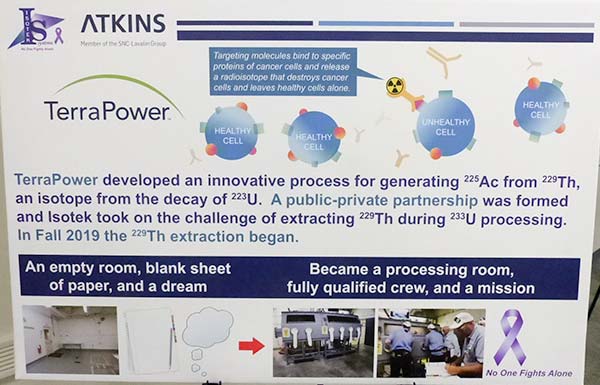
Federal officials and company executives said alpha-emitting isotopes such as actinium-225 could be used to treat prostate, acute myeloid leukemia, colorectal, and other cancers. “The short range of the alphas means that, if well targeted, treatment would be more effective with less damage to healthy tissue,” the fact sheet said. The potential use of alpha particles is still a relatively new science, and actinium-225 is not yet approved for use in the United States. But officials suggested its targeted nature could mean that it would compare favorably to chemotherapy, an existing cancer treatment that has side effects that cause people to lose their hair and feel bad.
“This is a much more targeted approach,” Levesque said.
Trials of actinium in other countries have shown promising results, Levesque said, but more research is needed in the United States, along with approval by the U.S. Food and Drug Administration.
Levesque said TerraPower has been studying what it calls targeted alpha therapy since 2013, and Friday’s celebration was the culmination of about five years of work.
He said the actinium-225 could be provided for what are known as monoclonal antibodies. TerraPower describes those as “heat-seeking missiles of cancer treatment” that can target proteins expressed by cancers. Levesque said the actinium would be like the payload, and the monoclonal antibodies would be like the truck that delivers the payload.
He said the amount that TerraPower will pay Isotek for the thorium is confidential, but it is in the range of millions of dollars. A fact sheet distributed at Friday’s announcement said TerraPower is paying a reasonable price for materials that don’t currently have a market.
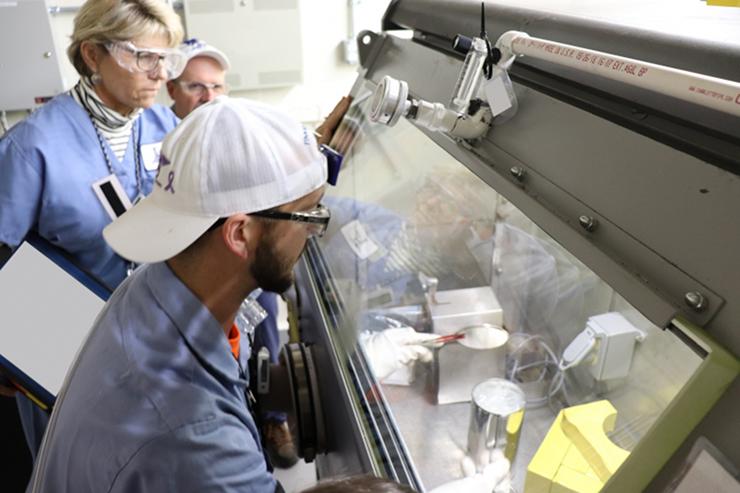
Isotek will use the money from the sale of the thorium-229 to pay for part of the project to dispose of the uranium-233 at ORNL.
“This approach allows down blending operations to begin a year ahead of schedule, accelerates the overall project schedule, and saves approximately $90 million taxpayer dollars,” federal officials and company executives said in a press release Friday.
The private funding of part of the cleanup project means DOE now expects to complete all processing operations of uranium-233 in 2025, the fact sheet said.
“Eliminating this inventory from storage will avoid sizable costs for DOE annually, benefiting taxpayers,” it said.
Besides Levesque and Bolon, other speakers at Friday’s celebration were DOE Deputy Under Secretary for Science Thomas L. Cubbage III, DOE Senior Advisor for Environmental Management to the Under Secretary for Science William “Ike” White, U.S. Senator Marsha Blackburn, and U.S. Representative Chuck Fleischmann.
“This is a waste product that is now going to be used to treat people with cancer,” said Fleischmann, whose district includes Oak Ridge.
About half of the uranium-233 (U-233) stored at ORNL has been transferred and disposed of, according to Friday’s press release. Oak Ridge Today reported two years ago, in November 2017, that about half of the U-233 stored in Building 3019 at ORNL had been shipped to Nevada National Security Site, a former nuclear weapons proving ground about 65 miles northwest of Las Vegas. That included waste from the Consolidated Edison Uranium Solidification Program, or CEUSP.
Other U-233 waste stored in secure vaults in Building 3019 at ORNL has included materials from glovebox research at ORNL, reactor plates, and conglomerate waste. Officials have previously said at least some of that waste will be treated, or “downblended,” at Building 2026, across the street from Building 3019. The DOE Oak Ridge Office of Environmental Management owns both buildings.
Removing the U-233 is the top-priority cleanup project at ORNL because, among other things, storing it at the lab increases security costs and creates nuclear safety issues. Building 3019 is the oldest operating nuclear facility in the world, according to DOE.
The remaining inventory of U-233 has to be processed and down blended before it can be disposed of. The processing of the remaining inventory began in the fall of 2019, and it is expected to be finished in 2024. The waste, which is stored in canisters, will be divided into smaller batches, blended with a weakened solution to lower the radiation dose, and mixed with concrete and shipped for low-level waste disposal.
Istotek recently began extracting thorium from the uranium-233 at ORNL, according to a video posted online by DOE. The thorium is extracted before the U-233 is down blended.
Extracting the thorium from the uranium involves three glove boxes, which were purchased using the private funding, according to DOE. Glove boxes are sealed chambers with windows where workers can insert their hands into gloves and work remotely with nuclear materials inside the box.
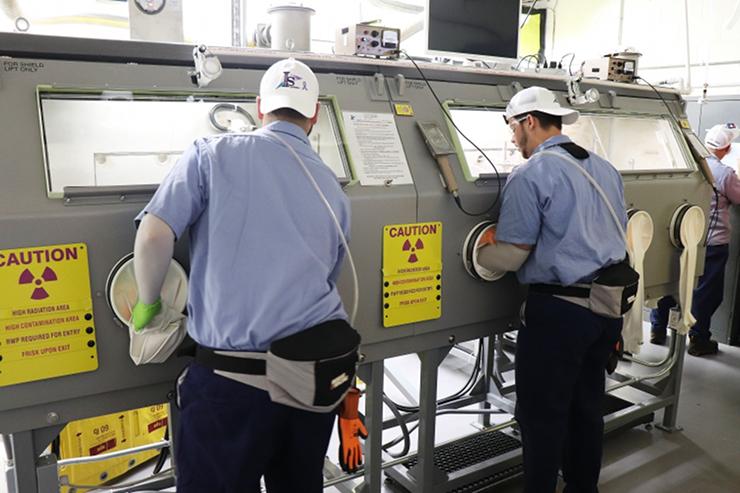
After being split into samples in one glove box, the uranium is mixed with nitric acid in a second to create a uranyl nitrate solution. It is pumped through two columns to remove first plutonium and then thorium using extraction resins. The uranyl nitrate that remains is pumped into a reservoir and put into a drum for disposal.
The thorium is removed from the extraction resin using a lower concentration nitric acid. It is then separated from the nitric acid in the third glove box, where the nitric acid is evaporated over a water bath, leaving about 70 milligrams of thorium.
A parallel process will be used to extract the actinium from the thorium in TerraPower’s lab in Everett, said Latkowski, the TerraPower senior vice president of innovation. A radioisotope generator could have something to attract thorium in a column. The thorium will decay to radium-225, which has a 15-day life, and actinium-225, which has a 10-day half life, Latkowski said. Those isotopes, which may not be attracted to the material that attracts the thorium in the column, could be flushed out with a solution.
Thorium-229 is an isotope generated by the decay of uranium-233. Uranium-233 is a radioactive isotope of uranium that does not exist in nature, but it can be produced by bombarding thorium-232 with neutrons. It was created as an additional fuel source for nuclear reactors in case uranium-235 ran out. But U-233 proved to be unviable as a fuel source because its creation generated uranium-232, a highly unstable radioactive isotope.
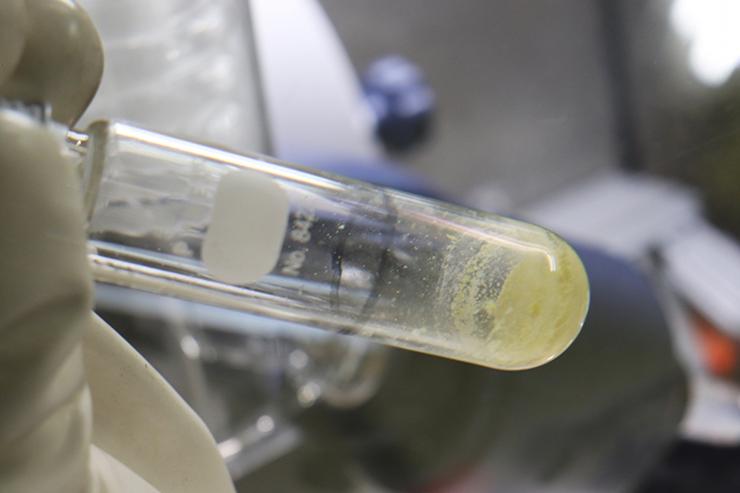
Bolon, of Isotek, said about two tons of uranium-233 were produced in the 1950s and early 1960s. U-232 decays to thalium-208, which emits high-energy gamma rays, Bolon said. Most of the uranium at ORNL has uranium-232 in it, so workers will use areas known as “hot cells,” which have more shielding and where workers can manipulate hazardous materials remotely with mechanical arms.
Bolon said the hot cells are being outfitted and processing could start in about a year.
More than 500 canisters of U-233 remain, mostly as uranium oxide but also in metal and ceramic monoliths. There are also sodium fluoride traps from the Molten Salt Reactor Experiment at ORNL, where uranium-233 fluoride salt and other fuels were tested.
About 60 canisters of Oak Ridge Oxide that were produced here can be processed in glove boxes, and that processing work will continue in the meantime, Bolon said.
The U.S. Department of Energy Office of Environmental Management announced in October that workers had started processing the U-233 powder in glove boxes a year ahead of schedule.
See our previous stories on uranium-233 here.
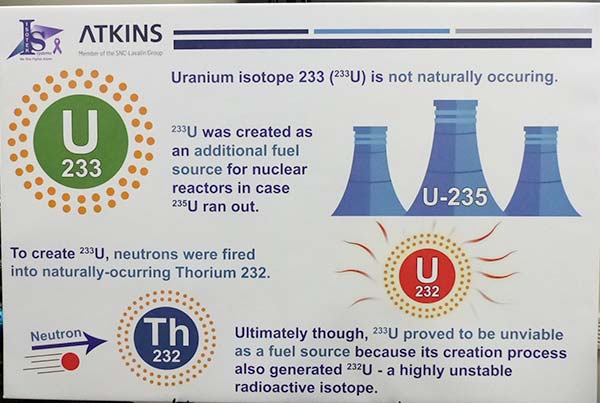
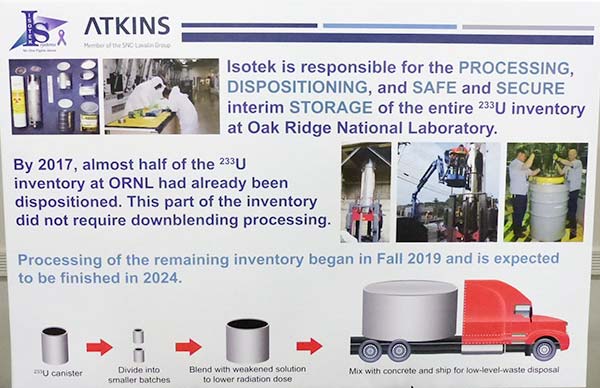
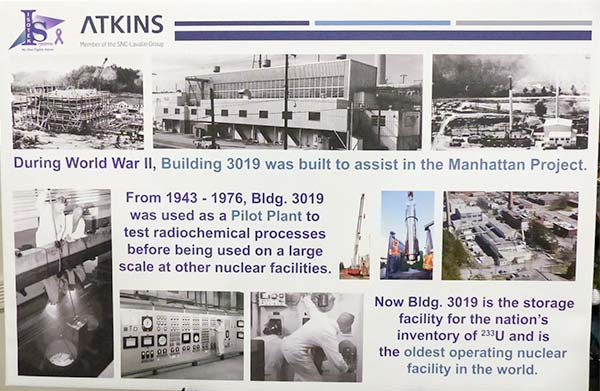
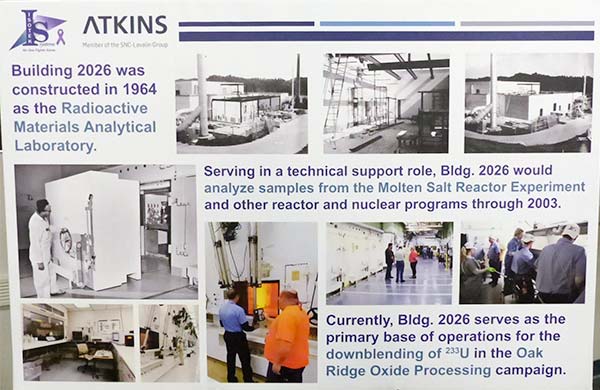
More information will be added as it becomes available.
You can contact John Huotari, owner and publisher of Oak Ridge Today, at (865) 951-9692 or john.huotari@oakridgetoday.com.
Most news stories on Oak Ridge Today are free, brought to you by Oak Ridge Today with help from our advertisers, sponsors, and subscribers. This is a free story. Thank you to our advertisers, sponsors, and subscribers. You can see what we cover here.
Do you appreciate this story or our work in general? If so, please consider a monthly subscription to Oak Ridge Today. See our Subscribe page here. Thank you for reading Oak Ridge Today.
Copyright 2019 Oak Ridge Today. All rights reserved. This material may not be published, broadcast, rewritten, or redistributed.
Leave a Reply